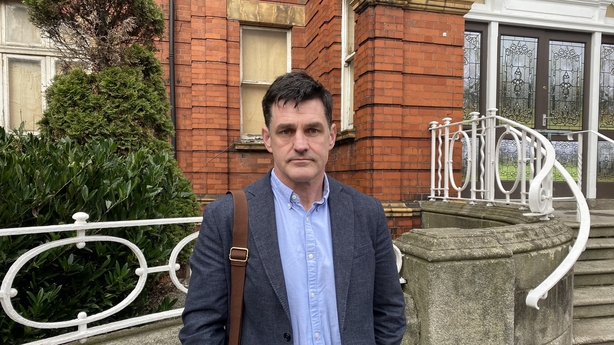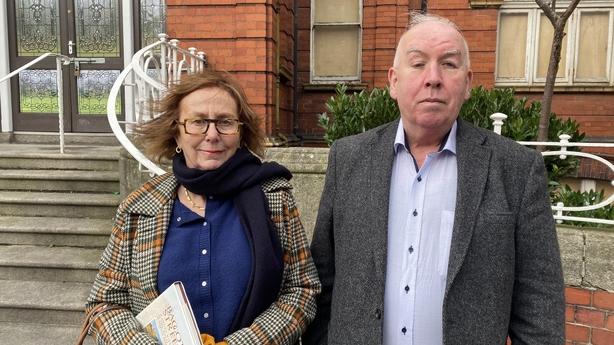Almost two-thirds of some 500 buildings put forward for refurbishment to house Ukrainian refugees were deemed unsuitable by the Department of Housing.
A spokesperson for the department said that around 320 of the buildings originally suggested were ruled out for a variety of reasons.
These included the time and/or cost of carrying out the refurbishment works, that some privately owned properties had been withdrawn, the state of dereliction of properties, a lack of utilities, that some buildings were already in use and that others were subject to legal disputes or title issues.
In April last year, the Cabinet was told that local authorities had identified more than 500 multi-occupancy buildings "that had potential" to be used to accommodate Ukrainian refugees under the Emergency Refurbishment (Ukraine) Programme, led by the Department of Housing.
In the end, just 182 of those properties were deemed suitable. However, a spokesperson for the department said that it would be willing to consider new recommendations.
Figures released by the department show that 121 properties, described as needing "little or no refurbishment work", were identified initially last year for use to accommodate over 5,000 Ukrainian refugees.
We need your consent to load this rte-player contentWe use rte-player to manage extra content that can set cookies on your device and collect data about your activity. Please review their details and accept them to load the content.Manage Preferences
However, RTÉ News has been unable to confirm how many people are currently being accommodated in these properties.
A department spokesperson said that 61 "more complex projects" which require "significant refurbishment" are now under way.
It is estimated that approximately 2,700 people could be accommodated in these properties once complete.
"Of these, there are procurement or works under way on 23 projects, with a further 38 projects at a survey/survey review stage," a spokesperson said, adding that "a definitive timeframe regarding completions cannot be provided".
Among these 61 properties, there are former hotels, B&Bs, pubs, hostels, office buildings, disused school buildings and former religious institutional buildings and convents.
The State is currently accommodating around 54,000 Ukrainian refugees.
As the war in Ukraine continues, so too does the demand for refugee accommodation and a Working Group to address this was recently established under the Taoiseach's department.
The Minister of State at the Department of Integration has said its disappointing that a large chunk of the accommodation identified to accommodate refugees is unsuitable.
Joe O'Brien said it was inevitable that some of the places identified would not be suitable, but he said the focus now was on the 60 locations that are being progressed, which he said would deliver 2,700 bed spaces.
The minister said there may more in the medium and long term.
He also said he and Minister Roderic O’Gorman were not comfortable with the State’s inability to provide accommodation to all those seeing international protection in Ireland.
'Hundreds more available State-owned buildings'
Architect Mel Reynolds believes that there are hundreds more "available State-owned buildings" that should be brought into use as accommodation, including some of those already deemed too costly or complex for refurbishment by the Department of Housing.
One such property is the Royal City of Dublin Hospital on Baggot Street.
It was on the original list of buildings considered under the Emergency Refurbishment (Ukraine) Programme.
On 28 April last year, Minister Eamon Ryan told the Dáil that it was "a perfect example" of the type of building that could be refurbished under the programme.
Mr Ryan said: "I support bringing it back to life, initially for displaced Ukrainian people, but also then getting over this inertia that seems to be in our system that allows buildings to lie derelict and has allowed vacancy to exist during a housing crisis.
"In some ways, one of the advantages we can take out of this crisis is that we then develop and open up buildings that have been shut for so long and refurbish them quickly."
However, a spokesperson for the Department of Housing confirmed that it was deemed unsuitable for refurbishment.
"The building has been assessed and the renovation costs have been initially estimated at €17 million, subject to a full feasibility study," the spokesperson said.
"Such a study would take approximately nine months before work could begin.
"The complexity, costs and time associated with refurbishing the whole site has put it out of the scope of the Ukrainian Emergency Refurbishment programme."

Mr Reynolds said that a property of this size, 5,600sqm, could deliver between 600 and 900 hostel-style bed spaces and said such a refurbishment would offer good value for money.
"Based on current rates the cost to refurbish (this building), per bed space, would be about a third the cost of modular temporary accommodation that is going to be housing Ukrainians," Mr Reynolds said.
"In terms of the feasibility, it's very easy, it's cellular accommodation, you have corridors and rooms, it shouldn't take that long to do a layout for this.
"For every euro you spend on this (refurbishment), you will gain three euro in value (to the property) so commercially it will make a huge amount of commercial sense as well."
Local residents and businesses first proposed refurbishing the building to house Ukrainian refugees in March last year, just weeks after the war began, when they submitted a plan to its owners, the Health Service Executive.
"A local developer offered to put up one million ... plus his own staff and they would come in, along with our own voluntary help and we would get the thing up and ready," Mick Quinn of the Baggot Street Traders Association told RTÉ News.

Siobhán Cuffe of the Pembroke Road Residents' Association said they would still like to see it used to offer shelter to refugees, although she said that the type of accommodation offered may not suit people in the longer term.
"It's a great location, there is a lot of goodwill in the neighbourhood, there are a lot of possibilities for people... we just want to see the building used," Ms Cuffe said.
Direct offers from departments and agencies
Separate from the list compiled by local authorities under the Emergency Refurbishment (Ukraine) Programme, potential refugee accommodation offers have been made directly by Government departments or State agencies.
For example, the Department of Health confirmed that around 300 HSE properties were offered directly to the Department of Children, Equality, Disability, Integration and Youth, which is responsible for managing available accommodation.
A spokesperson for the Department of Children said that "the properties in question required significant refurbishment and thus were not suitable for immediate use by this Department.
"It is expected that the list will be assessed by the Accommodation Working Group, which has recently been established under the Department of An Taoiseach," they said.
Separately, a spokesperson for the Department of Housing confirmed that while there may have been some overlap, all 300 HSE properties in question were not included in the 500 properties initially considered for the Emergency Refurbishment (Ukraine) Programme.
The Office of Public Works, which operates a register of more than 22,000 properties held by around 100 different public organisations, has confirmed that around 1,300 properties are currently marked "available".
However, it said that this "includes small parcels of land associated with road improvements or similar information".
"Therefore, in terms of "available" buildings that could be considered for housing or related developments, the number would be substantially lower."
A spokesperson for the OPW said: "Most of the organisations that hold property, including the OPW, have provided information on surplus properties to the relevant departments involved in either the provision of social housing or the provision of accommodation as part of the current humanitarian response."







